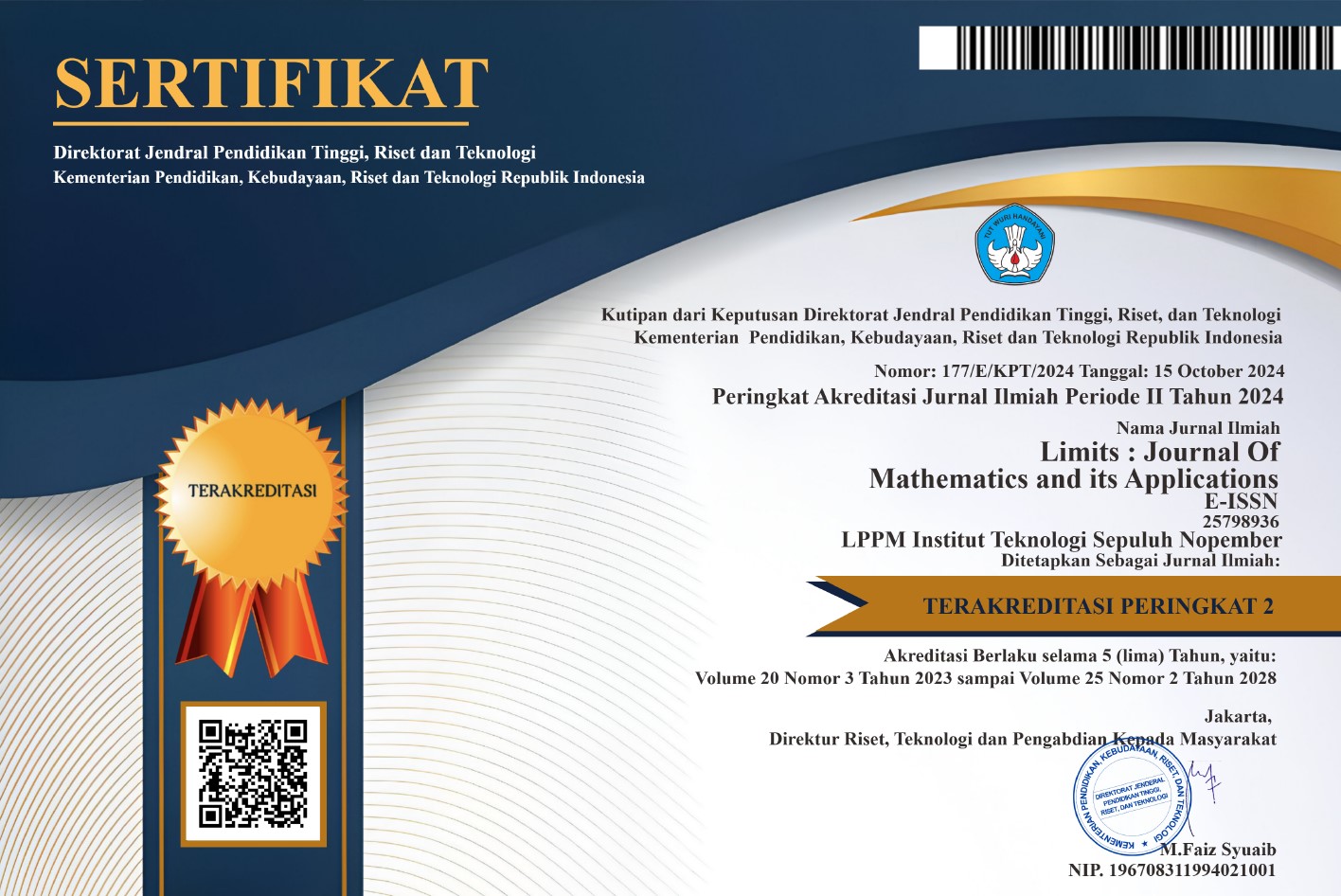Property Crime in Java Island 2022 based on Demography and Socioeconomic Aspects using Spatial Analysis Approach
DOI:
https://doi.org/10.12962/limits.v22i1.3371Keywords:
Property Crime, Criminality, Spatial Analysis, Java IslandAbstract
Property crime is the most common type of crime in Indonesia with the most rapid increasing in 2022. Java is the island with the highest magnitude of 65.85% if it is compared to the previous year and accounts for more than one third of the total cases in Indonesia. This study aims to determine an overview of these types of criminal offenses and the variables that affect them spatially. The analysis method uses in this study is descriptive analysis which will followed by inferential analysis, namely spatial analysis using Geographically Weighted Negative Binomial Regression (GWNBR). Based on this research, it is found that there are four regional groupings with variables that significantly affect all regions, namely life expectancy and Gini ratio. Meanwhile, there are variables that affect some regions, namely mean years schooling and total population. In addition, it is found that Geographically Weighted Negative Binomial Regression is better used than negative binomial regression in modeling property crime in Java Island in 2022.
Downloads
References
Global Initiative, “Global Organized Crime Index 2023,” 2023. [Online]. Available: https://ocindex.net/report/2023/0-3-contents.html.
Bareskrim Polri, “Jurnal Semester I Tahun 2022 Pusiknas Bareskrim Polri,” 2023.
A. D. Putra, G. S. Martha, M. Fikram, and R. J. Yuhan, “Faktor-Faktor yang Memengaruhi Tingkat Kriminalitas di Indonesia Tahun 2018,” Indones. J. Appl. Stat., vol. 3, no. 2, p. 123, 2021, doi: 10.13057/ijas.v3i2.41917.
S. M. Situmeang, “Fenomena Kejahatan Di Masa Pandemi Covid-19: Perspektif Kriminologi,” Maj. Ilm. UNIKOM, vol. 19, no. 1, pp. 35–43, 2021, doi: 10.34010/miu.v19i1.5067.
T. Ward, “Why theory matters in correctional psychology,” Aggress. Violent Behav., vol. 48, no. August, pp. 36–45, 2019, doi: 10.1016/j.avb.2019.08.015.
K. Fachrurrozi, Fahmiwati, L. Hakim, Aswadi, and Lidiana, “Pengaruh kemiskinan dan pengangguran terhadap kriminalitas di indonesia di tahun 2019,” J. Real Ris., vol. 3, no. 2, pp. 173–178, 2021, doi: 10.47647/jrr.
Badan Pusat Statistik, Statistik Kriminal 2023. 2023.
D. K. Rahayu and S. Martini, “Peran Moda Transportasi Darat Dalam Mobilitas Tenaga Kerja,” J. Transp., vol. 22, no. 2, pp. 109–116, 2022, doi: 10.26593/jtrans.v22i2.6061.109-116.
R. M. Sabiq and N. Nurwati, “Pengaruh Kepadatan Penduduk Terhadap Tindakan Kriminal,” J. Kolaborasi Resolusi Konflik, vol. 3, no. 2, p. 161, 2021, doi: 10.24198/jkrk.v3i2.35149.
D. C. Puspitasari, “Pemodelan Persentase Kriminalitas Di Jawa Timur Berdasarkan Pendekatan Geographically Weighted Regression,” 2020, [Online]. Available: https://repository.unair.ac.id/95273/.
Z. Resiana and T. Aditya, “Analitik Geovisual Pengaruh Pandemi COVID-19 Terhadap Pola Dan Kecenderungan Kriminalitas di Daerah Istimewa Yogyakarta,” JGISE J. Geospatial Inf. Sci. Eng., vol. 6, no. 1, pp. 24–37, 2023, doi: 10.22146/jgise.80670.
E. Febrianti, B. Susetyo, and P. Silvianti, “Pemodelan Tingkat Kriminalitas di Indonesia Menggunakan Analisis Geographically Weighted Panel Regression,” Xplore J. Stat., vol. 12, no. 1, pp. 91–109, 2023, doi: 10.29244/xplore.v12i1.950.
S. Rahmalia, Ariusni, and M. Triani, “Pengaruh Tingkat Pendidikan, Pengangguran, dan Kemiskinan Terhadap Kriminalitas di Indonesia,” J. Kaji. Ekon. dan Pembang., vol. 1, no. 1, pp. 21–36, 2021.
E. Y. Purwanti and E. Widyaningsih, “Analisis Faktor Ekonomi yang Mempengaruhi Kriminalitas di Jawa Timur,” J. Ekon., vol. 9, no. 2, pp. 154–177, 2019.
A. O. Edwart and Z. Azhar, “Pengaruh Tingkat Pendidikan, Kepadatan Penduduk Dan Ketimpangan Pendapatan Terhadap Kriminalitas Di Indonesia,” J. Kaji. Ekon. dan Pembang., vol. 1, no. 3, p. 759, 2019, doi: 10.24036/jkep.v1i3.7703.
H. D. Purnomo, “Peran Tim Anti Bandit Satreskrim Polrestabes Surabaya dalam penanggulangan tindak pidana kejahatan jalanan,” J. Sosiol. Dialekt., vol. 14, no. 1, p. 34, 2019, doi: 10.20473/jsd.v14i1.2019.34-43.
A. S. Wicaksono and Suharto, “Analisis pengaruh faktor ekonomi terhadap kriminalitas di Kabupaten/Kota Daerah Istimewa Yogyakarta,” J. Kebijak. Ekon. dan Keuang., vol. 2, no. 1, pp. 50–57, 2023, doi: 10.20885/jkek.vol2.iss1.art6.
H. B. Putra and N. H. Purnomo, “Persepsi Penduduk Terhadap Potensi Kriminal Di Permukiman Baru MERR (Middle East Ring Road) Kecamatan Sukolilo Kota Surabaya,” Swara Bhumi, vol. 05, no. 01, pp. 105–113, 2017.
C. S. Dunkel, E. Mathes, and K. M. Beaver, “Life history theory and the general theory of crime: Life expectancy effects on low self-control and criminal intent,” J. Soc. Evol. Cult. Psychol., vol. 7, no. 1, pp. 12–23, 2013, doi: 10.1037/h0099177.
R. Sandiyantanti, “Analisis Kejahatan dengan Modus Perampasan Secara Paksa,” J. Apl. Adm., vol. 18, no. 1, pp. 20–28, 2015, [Online]. Available: https://jaa.hangtuah.ac.id/index.php/jurnal/article/download/29/22/52.
M. Hooghe, B. Vanhoutte, W. Hardyns, and T. Bircan, “Unemployment, inequality, poverty and crime: Spatial distribution patterns of criminal acts in Belgium, 2001-06,” Br. J. Criminol., vol. 51, no. 1, pp. 1–20, 2010, doi: 10.1093/bjc/azq067.
J. Phillips and K. C. Land, “The link between unemployment and crime rate fluctuations: An analysis at the county, state, and national levels,” Soc. Sci. Res., vol. 41, no. 3, pp. 681–694, 2012, doi: 10.1016/j.ssresearch.2012.01.001.
Bareskrim Polri, Jurnal Pusat Informasi Kriminal Nasional Tahun 2022 Edisi Tahun 2023. 2023.
Y. Ruchiyani, B. Suriadi, N. Nainita, N. Cahaya, and N. Al-Ridho, “Faktor-faktor Penyebab Kerentanan Ekonomi Indonesia,” J. Cakrawala Ilm., vol. 1, no. 6, pp. 1575–1584, 2022.
V. E. Flango and E. L. Sherbenou, “Poverty, Urbanization, and Crime,” Criminology, vol. 14, no. 3, 1976, [Online]. Available: http://doi.wiley.com/10.1111/j.1745-9125.1976.tb00027.x%5Cnpapers3://publication/doi/10.1111/j.1745-9125.1976.tb00027.x.
E. B. Patterson, “Poverty, Income Inequality, and Community Crime Rates,” Criminology, vol. 29, no. 4, pp. 755–776, 1991, doi: 10.1111/j.1745-9125.1991.tb01087.x.
E. A. Rahman, S. Halim, and Haetami, “Implementasi Kebijakan Kota Surabaya untuk Mengatasi Ketimpangan Sosial Ekonomi Masyarakat dalam Mewujudkan Stabilitas Keamanan Daerah,” J. Kaji. Akad. dan Literasi Ilmu Ekon. Pertahanan, vol. 5, no. 2, pp. 43–70, 2019.
D. R. Ningsih, P. K. I. Intan, and D. Yuliati, “Pemodelan Tindak Pidana Kriminalitas di Kota Tangerang Menggunakan Metode Regresi Lasso,” Estimasi J. Stat. Its Appl., vol. 4, no. 1, pp. 64–77, 2023, doi: 10.20956/ejsa.vi.24853.





